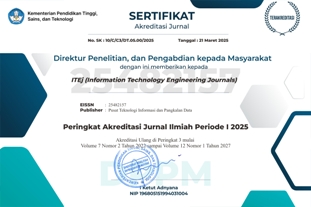Decision Support System for Determining the Eligibility of Economically Disadvantaged Students for Assistance Using the K-Means and MOORA Methods
Abstract
The determination of recipients for student financial aid often faces challenges related to subjectivity in the selection process, necessitating a system capable of conducting objective analysis. This study develops a Decision Support System using the K-Means method to cluster students based on similar socioeconomic characteristics and the MOORA method to rank aid recipients more accurately. The K-Means method is applied to classify students into three clusters based on parental income, number of dependents, and academic performance. The clustering results indicate that students in Cluster 1 belong to the lowest economic group, making them the top priority in the selection process. Subsequently, the MOORA method is used to rank students within Cluster 1 based on an optimal value calculated from the weighted benefit and cost criteria. This calculation produces a priority ranking that is more transparent and objective compared to conventional selection systems. The findings show that the combination of K-Means and MOORA methods enhances accuracy in selecting aid recipients while reducing subjectivity in the selection process. With this system, schools or relevant institutions can expedite decision-making and ensure that aid is distributed to the students most in need. This study is expected to serve as a solution for educational institutions in improving the effectiveness and efficiency of student welfare programs.
Downloads
References
M. Reza, “Sistem Pendukung Keputusan Penerima Program Indonesia Pintar (PIP) Menggunakan Metode MOORA,” 2022.
M. Suginan, E. Suryani, and U. L. Sapria, “Sistem Pendukung Keputusan Penerima Bantuan Siswa Miskin Menerapkan Metode WASPAS dan MOORA,” Nas. Sains Teknol. Inf., pp. 719â, vol. 727, 2018.
K. Kurniawan, J. Prayudha, and Z. Panjaitan, “Sistem Pendukung Keputusan Penentuan Penerimaan Beasiswa Menggunakan Metode Moora,” J. Cyber Tech, vol. 1, no. 2, pp. 232–245, 2018.
L. Cahyani, M. Arif, and F. Ningsih, “Sistem Pendukung Keputusan Pemilihan Mahasiswa Berprestasi Menggunakan Metode Moora (Studi Kasus Fakultas Ilmu Pendidikan Universitas Trunojoyo Madura,” J. Ilm. Edutic Pendidik. Dan Inform., vol. 5, no. 2, pp. 108–114, 2019.
H. Haryanto, “Pembuatan Aplikasi Sistem Penunjang Keputusan Untuk Pemilihan Penerima Beasiswa Siswa KMS dengan Metode MOORA,” J. Inf. J. Penelit. Dan Pengabdi. Masy., vol. 4, no. 1, pp. 15–19, 2018.
Y. Rohmatin, W. Kusrini, A. Noor, and F. Fathurrahmani, “Sistem Pendukung Keputusan Penentuan Calon Penerima Beasiswa Menggunakan Metode Simple Additive Weighting (SAW) Berbasis Web,” J. Sains dan Inform., vol. 6, no. 1, pp. 102–111, 2020.
A. Romadhona, U. Ulfiah, S. Sukardi, and N. I. Sari, “Implementasi Seleksi Penerimaan Bantuan Siswa Miskin Dengan Metode Moora,” JTIK (Jurnal Tek. Inform. Kaputama), vol. 7, no. 1, pp. 128–135, 2023.
D. Darlinda and J. N. Utamajaya, “Sistem Pendukung Keputusan Penerima Beasiswa Program Indonesia Pintar Menggunakan Metode Algoritma K-Means Clustering,” JURIKOM (Jurnal Ris. Komputer), vol. 9, no. 2, pp. 167–175, 2022.
Y. Amaliah, “Sistem Pendukung Keputusan Penerima Beasiswa Tidak Mampu Menggunakan Metode Moora,” J. Teknol. Inf., vol. 5, no. 1, pp. 12–18, 2021.
N. W. A. Ulandari, “Implementasi metode MOORA pada proses seleksi beasiswa bidikmisi di Institut Teknologi dan Bisnis STIKOM Bali,” J. Eksplora Inform., vol. 10, no. 1, pp. 53–58, 2020.
Y. S. Siregar, “Analisis Penerima Bantuan Beasiswa Program Studi Teknik Informatika Menggunakan Metode Moora Dan Topsis,” JiTEKH, vol. 9, no. 1, pp. 58–64, 2021.
R. F. Sinaga, S. R. Andani, and S. Suhada, “Penentuan Penerima Kip Dengan Menggunakan Metode Moora Pada Sd Negeri 124395 Pematang Siantar,” KOMIK (Konferensi Nas. Teknol. Inf. dan Komputer), vol. 2, no. 1, pp. 278–285, 2018.
E. Nahak, F. Tedy, Y. C. H. Siki, E. Ngaga, E. Jando, and S. D. B. Mau, “Implementasi Metode MOORA dalam Sistem Pendukung Keputusan bagi Calon Penerima Beasiswa Program Indonesia Pintar di SMPN Satu Atap Nununamat,” KONSTELASI Konvergensi Teknol. dan Sist. Inf., vol. 4, no. 1, pp. 83–98, 2024, doi: 10.24002/konstelasi.v4i1.8972.
R. P. Sari and A. M. Alliandaw, “Penerapan Metode MOORA Pada Sistem Penentuan Penerimaan Bidikmisi UNTAN,” J. Sisfokom (Sistem Inf. dan Komputer), vol. 11, no. 2, pp. 242–250, 2022, [Online]. Available: https://jurnal.atmaluhur.ac.id/index.php/sisfokom/article/view/1420
E. Patel and D. S. Kushwaha, “Clustering cloud workloads: K-means vs gaussian mixture model,” Procedia Comput. Sci., vol. 171, pp. 158–167, 2020.
A. Žiberna, “K-means-based algorithm for blockmodeling linked networks,” Soc. Networks, vol. 61, pp. 153–169, 2020.
C. L. Clayman, S. M. Srinivasan, and R. S. Sangwan, “K-means clustering and principal components analysis of microarray data of L1000 landmark genes,” Procedia Comput. Sci., vol. 168, pp. 97–104, 2020.
J. Hutagalung, N. L. W. S. R. Ginantra, G. W. Bhawika, W. G. S. Parwita, A. Wanto, and P. D. Panjaitan, “COVID-19 cases and deaths in Southeast Asia clustering using K-Means algorithm,” in Journal of Physics: Conference Series, 2021, vol. 1783, no. 1, p. 12027.
A. P. U. Siahaan, R. Rahim, and M. Mesran, “Student Admission Assesment using Multi-Objective Optimization on the Basis of Ratio Analysis,” 2017.
M. Moradian, V. Modanloo, and S. Aghaiee, “Comparative analysis of multi criteria decision making techniques for material selection of brake booster valve body,” J. traffic Transp. Eng. (English Ed., vol. 6, no. 5, pp. 526–534, 2019.









